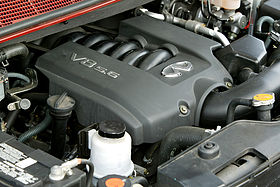|
Nissan VK engine
The VK engine (formerly known as the ZH) is a V8 piston engine from Nissan. It is an aluminum DOHC 4-valve design. The VK engine was originally based on Nissan's VQ V6 rather than the VH V8 used in previous Q45/Cima models. Changes include: a variable intake manifold, newly designed heads, and a larger drive by wire throttle chamber. The intake manifold directs air through different paths at different engine speeds to optimise low-end torque or high-end horsepower. VK45DE The 4,494 cc (4.5 L; 274.2 cu in) VK45DE was introduced in 2002 and is built in Yokohama, Japan. Bore and stroke is 93 mm × 82.7 mm (3.66 in × 3.26 in). Output is 340 hp (254 kW; 345 PS) at 6,400 rpm with 46 kg⋅m (451 N⋅m; 333 lbf⋅ft) of torque at 4,000 rpm. Redline is at 6,600 rpm. It has an aluminum engine block and aluminum DOHC cylinder heads. It uses SFI, has 4 titanium valves per cylinder with Continuous Variable Valve Timing and features forged steel connecting rods, 4 one-piece cast camshafts, an unusual variable-flow induction system optimizes airflow for low- and high-speed operation, low-friction molybdenum-coated pistons, and a microfinished forged crankshaft. MotorsportA flat-plane crankshaft version of the VK45DE was used by Nismo for Super GT races with the Nissan GT-R instead of using the GT-R's VR38DETT twin-turbo V6 engine.[1] The VK45DE was previously used in Nissan's 350Z Super GT car in 2007, replacing the previous VQ30DETT used in that car. In race trim, the Super GT VK45DE produces 500 PS (368 kW; 493 hp) and 52 kg⋅m (510 N⋅m; 376 lbf⋅ft) of torque.[2] The engine idles at around 3,500 rpm and is restricted to the above specified power output. Without such restrictions, the engine is reputedly capable of producing nearly 800 PS (588 kW; 789 hp).[3] Nismo reasons that by using the engine, they eliminate turbo lag, save weight and generally prefer the torque curve of the atmospheric V8. Also in the Super GT series, an unbranded VK45DE is used for "Mother Chassis" cars; the engine is labeled the GTA V8.[4] Applications
VK45DDThe VK45DD is a 4,494 cc (4.5 L; 274.2 cu in) V8 engine that is very similar to the VK45DE but adds a direct injection fuel system. This was Nissan's first V8 with direct injection (NEO-Di). It officially produces 280 PS (206 kW; 276 hp) at 6,000 rpm and 46 kg⋅m (451 N⋅m; 333 lbf⋅ft) at 3,600 rpm, but it has unofficially over 300 PS (221 kW; 296 hp). It has a compression ratio of 11.0:1, and a bore and stroke of 93 mm × 82.7 mm (3.66 in × 3.26 in). Applications
VK50VE The VK50VE is a 5,026 cc (5.0 L; 306.7 cu in) V8 engine with 390 hp (291 kW) at 6,500 rpm and 51 kg⋅m (500 N⋅m; 369 lbf⋅ft) at 4,400 rpm and redline is set at 6,800 rpm. Bore x stroke are 95.5 mm × 87.7 mm (3.76 in × 3.45 in) and compression ratio is 10.9:1. The valvetrain is a dual overhead cam (DOHC) design with a continuously variable valve timing control system (CVTCS). The engine also features Nissan's VVEL valve timing technology.[5] Applications
VK56DE The VK56DE is a 5,552 cc (5.6 L; 338.8 cu in) version built in Decherd, Tennessee. Bore and stroke is 98 mm × 92 mm (3.9 in × 3.6 in). Output is 317–320 hp (236–239 kW; 321–324 PS) at 4,900 rpm with 522 to 533 N⋅m (385 to 393 lb⋅ft) of torque at 3,600 rpm. It has aluminum-alloy block and heads and low-friction molybdenum-coated pistons. The valvetrain is a dual overhead cam (DOHC) design with a continuously variable valve timing control system (CVTCS) on the intake valves. It also has 4 valves per cylinder with micro-finished camshafts and ductile iron cylinder liners for increased durability. MotorsportNismo used the VK56DE for FIA GT1 racing in the Nissan GT-R GT1 from 2010 to 2011. In race trim, it produced 600 hp (447 kW) and 650 N⋅m (479 lbf⋅ft) of torque.[6] The Nissan Motorsport VK56DE was launched in Australia for the V8 Supercars Championship in 2013 by Kelly Racing in Melbourne. The engine has been reduced in capacity to 4,990 cc (5.0 L; 304.5 cu in) to fit the V8 Supercars regulations. It has a bore and stroke of 102.69 mm × 75.31 mm (4.04 in × 2.96 in). It was fitted to a Nissan Altima version of the V8 Supercars "Car of the Future" specification that competed from 2013 until 2019.[7] Applications
Notes:
VK56VD The VK56VD is a 5,552 cc (5.6 L; 338.8 cu in) 32-valve, DOHC, Direct Injection Gasoline (DIG) aluminum-alloy V8 and features Nissan's latest VVEL (Variable Valve Event & Lift System). The direct injection system provides better wide-open throttle performance and improved fuel economy and emissions performance by reducing engine knock, improving combustion stability and controlling injection more precisely. Applications
References
See also |
|||||||||||||||||||||||||||||||||||||||||||||||||||||||||||||||||||||||||||||||||||||||||||||||||||||||||||||||||||||||||||||||||||||||||||||||||||||||||||||||||||||||||||||||||||||||
